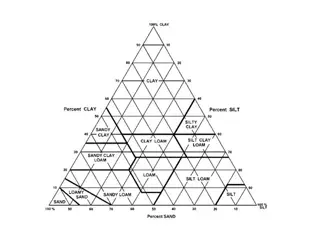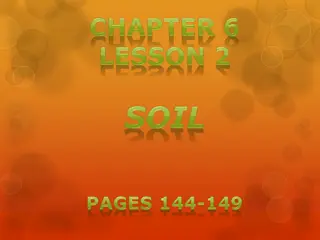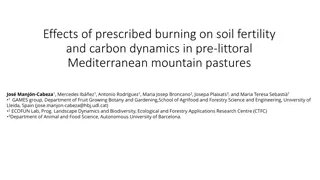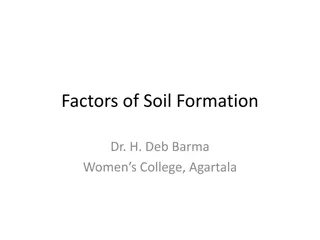Understanding the Role of Sodium and Salts in Soil Structure
Soil structure plays a crucial role in plant growth, water movement, and drainage. Excess sodium can cause clay particles to disperse, leading to reduced water infiltration. Flocculation, which involves cations like calcium and magnesium, helps clay particles stick together to form aggregates, improving soil structure. Proper management of cations can enhance soil flocculation and aggregate formation, benefiting soil health and plant growth.
Download Presentation

Please find below an Image/Link to download the presentation.
The content on the website is provided AS IS for your information and personal use only. It may not be sold, licensed, or shared on other websites without obtaining consent from the author. Download presentation by click this link. If you encounter any issues during the download, it is possible that the publisher has removed the file from their server.
E N D
Presentation Transcript
Soil Structure: The Roles of Sodium and Salts Dr. Jim Walworth Department of Soil, Water and Environmental Science University of Arizona AZ 1414 Revised 10/2011 The University of Arizona Cooperative Extension
Soil clay particles can be unattached to one another (dispersed) or clumped together (flocculated) in aggregates. Soil aggregates are cemented clusters of sand, silt, and clay particles. Dispersed Particles Flocculated Particles The University of Arizona Cooperative Extension
Flocculation is important because water moves mostly in large pores between aggregates. Also, plant roots grow mainly between aggregates. The University of Arizona Cooperative Extension
In all but the sandiest soils, excess sodium causes clays to disperse. Dispersed clay plugs soil pores and impedes water infiltration and soil drainage. The University of Arizona Cooperative Extension
Most clay particles have a negative electrical charge. Like charges repel, so clay particles repel one another. Negatively charged clay particle Negatively charged clay particle The University of Arizona Cooperative Extension
A cation is a positively charged molecule. Common soil cations include sodium (Na+), potassium (K+), magnesium (Mg2+), and calcium (Ca2+). Cations can make clay particles stick together (flocculate). + Negatively charged clay particle Negatively charged clay particle The University of Arizona Cooperative Extension
If we add the right cations to a dispersed soil the soil will flocculate and form aggregates The University of Arizona Cooperative Extension
Flocculating Cations We can divide cations into two categories Weak flocculators Sodium Strong flocculators Calcium Magnesium Relative Flocculating Power Ion Sodium Na+ 1.0 Potassium K+ 1.7 Magnesium Mg2+ 27.0 Calcium Ca2+ 43.0 Sumner and Naidu, 1998 The University of Arizona Cooperative Extension
Flocculating Power of Cations Cations in water attract water molecules because of their charge, and become hydrated. (+) Water molecule is polar: (+) on one end, (-) on the other end Hydrated cation surrounded by water molecules (+) + (-) Cations with a single charge and large hydrated radii are the poorest flocculators. Charges per molecule Hydrated radius (nm) Relative Cation flocculating power Sodium 1 0.79 1.0 Potassium 1 0.53 1.7 Magnesium 2 1.08 27.0 Calcium 2 0.96 43.0 The University of Arizona Cooperative Extension
Sodium Adsorption Ratio The ratio of weak to strong flocculators gives an indication of the relative status of these cations: + + + + + + + ++ ++ ++ Ca2+ and Mg2+ ++ ++ ++ ++ Mathematically, this is expressed as the sodium adsorption ratio or SAR: [Na+] SAR = [Ca2+] + [Mg2+] where concentrations are expressed in mmoles/L The University of Arizona Cooperative Extension
Exchangeable Sodium Percentage An alternative to SAR is ESP, Exchangeable Sodium Percentage + ++ ++ + + - - - - - - - ++ ++ - - Ca2+ and Mg2+ + ++ ++ + Mathematically, this is expressed as the percentage of the CEC (cation exchange capacity) that is filled with sodium in units of charge per mass (cmolc/kg) ESP = Cation Exchange Capacity Na+ SAR and ESP are approximately equal numerically The University of Arizona Cooperative Extension
Measuring Soil Salts Ions in solution conduct electricity, so the total amount of or soluble soil ions (salts) can be estimated by measuring the Electrical Conductivity (EC) of a soil water extract. EC is measured in units of conductance over a known distance: deci-Siemens per meter or dS/m High EC = salty soil Low EC = non-salty soil Soil salts can also be expressed as Total Dissolved Salts (TDS) in ppm TDS = EC (dS/m) x 640 + - - - + - + + - + + + - - + - - + + + - - - + - + + - + - The University of Arizona Cooperative Extension
Aggregate stability (dispersion and flocculation) depends on the balance (SAR) between (Ca2+ and Mg2+) and Na+ as well as the amount of soluble salts (EC) in the soil. + + + ++ ++ ++ + + + + ++ ++ ++ ++ EC Lower EC Higher EC Flocculated soil Dispersed soil The University of Arizona Cooperative Extension
Soil particles will flocculate if concentrations of (Ca2+ + Mg2+) are increased relative to the concentration of Na+ (SAR is decreased). EC Dispersed soil Flocculated soil The University of Arizona Cooperative Extension
Soil particles will disperse if concentrations of (Ca2+ + Mg2+) are decreased relative to the concentration of Na+ (SAR is increased). EC Flocculated soil Dispersed soil The University of Arizona Cooperative Extension
Soil particles will flocculate if the amount of soluble salts in the soil is increased (increased EC), even if there is a lot of sodium. EC Lower EC Higher EC Dispersed soil Flocculated soil The University of Arizona Cooperative Extension
Soil particles may disperse if the amount of soluble salts in the soil is decreased (i.e. if EC is decreased). EC Lower EC Higher EC Flocculated soil Dispersed soil The University of Arizona Cooperative Extension
If soils are close to the tipping point between flocculation and dispersion, the quality of irrigation water will influence aggregate stability. If irrigation water infiltrates, and rain water does not, this indicates that the soil is close to the tipping point . If soils are irrigated with clean water (with low EC), soil EC will decrease, which can destabilize aggregates. Irrigation water will infiltrate slowly. EC Higher EC Lower EC Flocculated soil EC Soils irrigated with saline water (with high EC) will generally have good structure, and water will infiltrate rapidly. However, salts can accumulate and damage plants unless properly managed. Higher EC Lower EC Dispersed soil The University of Arizona Cooperative Extension
Soils can be classified by the amount of soluble salts (EC) and sodium status (SAR). This classification can tell us something about soil structure. Soil Classification Normal EC <4 SAR <13 Condition Flocculated Saline >4 <13 Flocculated Sodic <4 >13 Dispersed Saline-Sodic >4 >13 Flocculated The University of Arizona Cooperative Extension
Observe your soil - sodic soils absorb water slowly and often crack when dry The University of Arizona Cooperative Extension
Controlling Na+ requires increasing concentrations of soluble Ca2+ to decrease soil or water SAR, thus favoring soil flocculation. EC Flocculated soil Dispersed soil The University of Arizona Cooperative Extension
Increasing soluble calcium improves aggregate stability in soils with poor structure. Gypsum CaSO4 EC Dispersed soil Flocculated soil The University of Arizona Cooperative Extension
Apply gypsum before leaching salts out of soils susceptible to dispersion (the amount of gypsum needed can be determined by a soil test). Replacing sodium with calcium before leaching will stabilize soil structure. Ca2+ SO42- Ca++ Ca++ - - - - - - - - - Ca++ Ca++ Na+ Na+ Na+ - - - - Na+ - - - - - Na+ Na+ Na+ Na+ Na+ Na+ Na+ Na+ Na+ Na+ Na+ Na+ The University of Arizona Cooperative Extension
Sulfuric acid* can be used instead of gypsum on calcareous (CaCO3containing) soil only. Sulfuric acid dissolves calcium carbonate in the soil + + + H SO 2 CaCO CO H O CaSO 2 4 3 2 4 and makes gypsum! *Sulfuric acid is extremely dangerous and should only be handled by trained personnel. The University of Arizona Cooperative Extension
Elemental sulfur can also be used as an alternative to gypsum on calcareous soils Soil microbes convert sulfur into sulfuric acid + + + + 2 S O CO H O 2 H SO 2 CH O 2 2 4 2 H2SO4 dissolves calcium carbonate and makes gypsum Conversion to sulfuric acid takes time several weeks faster in warm soils The University of Arizona Cooperative Extension
Alternatives to Gypsum: Sulfur burners S + O2 SO2 SO2 + H2O H2SO3 (sulfurous acid) Sulfur burners eliminate the need for handling dangerous sulfuric acid The University of Arizona Cooperative Extension
Relative effectiveness of amendments for supplying calcium Chemical composition Solubility in water (lbs/100 gal) Amount (lbs) equivalent to 1 lb of gypsum Amendment Gypsum CaSO4.2H2O CaCl2.2H2O H2SO4 S 2.0 1.0 Calcium chloride 810 0.9 Sulfuric acid Very high 0.6 Sulfur 0 0.2 Ammonium thiosulfate (NH4)2S2O3 850 0.5 - 1.4 Potassium thiosulfate K2S2O3 1290 1.1 Aluminum sulfate Al2(SO4)3.18H2O 725 1.3 The University of Arizona Cooperative Extension
Manage soil structure Be aware of the quality of irrigation water. Water with high levels of sodium (high SAR) will tend to destabilize soil. Have irrigation water analyzed for SAR and EC or ask your water provider for analyses. If you have high sodium irrigation water, the water and/or the soil may need amendments such as gypsum or sulfuric acid. Observe your soil. If water infiltrates very slowly, or if rain water infiltrates more slowly than irrigation water, the soil may have a sodium problem. Sodium impacted soils may noticeably crack when dry. Analyze your soil. Laboratory analysis can tell you the soil EC and SAR or ESP. The University of Arizona Cooperative Extension
cals.arizona.edu/pubs/crops/az1414 Issued in furtherance of Cooperative Extension work, acts of May 8 and June 30, 1914, in cooperation with the U.S. Department of Agriculture, Kirk A. Astroth, Interim Director, Cooperative Extension, College of Agriculture & Life Sciences, The University of Arizona. The University of Arizona is an equal opportunity, affirmative action institution. The University does not discriminate on the basis of race, color, religion, sex, national origin, age, disability, veteran status, or sexual orientation in its programs and activities. The University of Arizona Cooperative Extension























